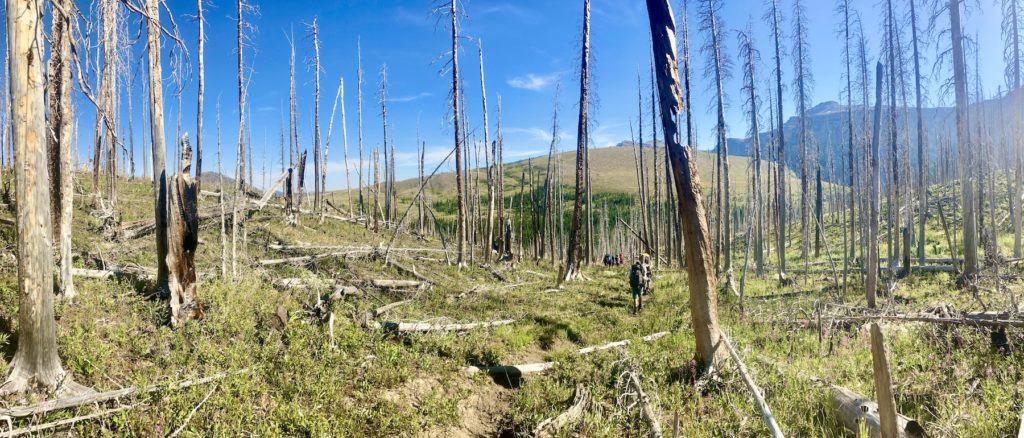
The wildflowers are fading as fall is fast approaching on the slopes of the Northern Rockies, and I start to notice purple. Tearing my eyes away from the corpses of burnt trees, I start to observe a different narrative, one of wildflowers and exposed outcrops of rocks. One of lodgepole pines reaching their teen years; big skies, and wild berries scattered underfoot.
As a geologist, I notice the rocks scattered along the trail, then berries hidden beneath shading leaves. I notice wildflowers in the prairie grasses, peeking their petals out from the wild underbrush. Eventually, I begin to take in the colors. White and gray rocks being kicked loose by our stampede of hiking boots, yellow and white flowers sprinkled among the underbrush, and plenty of green leaves, painting the freshly watered landscape. But popping up, to my surprise, is the color purple. Purple flowers, purple berries, and purple rocks.
Dark purple asters stand up stiffly, soaking up the last of the summer sun before fall overtakes them, persisting as far as the grasses grow. A delicate purple mountain harebell sits in the shade of a pine tree, surrounded by bear grass, waiting for a pollinator to grace its carefully chosen home. Fireweed sprouts vibrant shades of purple in the vast grasslands and sunny remains of a burnt forest. Thick, spiny thistles with thin purple petaled flowers tower over their fellow grassland counterparts. The purple in these flowers comes from the anthocyanin in their petals, a shade that comes from a well balanced soil pH.
Wildflowers use the power of color along with scent and shape to attract pollinators. In return for their sweet nectar, pollinators spread pollen from one flower to another. Flowering plants co-evolved with insects and other pollinators on their epochal journey to become the largest division of plants today. In this nifty partnership, purple flowers use pollinators’ ultraviolet vision to usher them toward vibrant landing pads to collect nectar and pollen. Most flowers use small differences to attract different pollinators, but all of these anthocyanin-filled flowers tell stories. All I need to do is take a second to stop and listen.
The purple rocks appear suddenly along the trail, replacing the white and brown ones that I saw moments before. The rugged, coarse sandstone and brittle gray shale has given way to a coarse grained, but smooth rock with a beautiful, dark purple complexion. At first, seeing a purple rock in an area known for its white limestone seemed unusual. Why would a sedimentary rock come in this shade? The crystals glittering within the rock may suggest metamorphism. If so, this rock holds the mutilated history of old ocean floors, formed through extreme heat and pressure, powerful enough to reorganize the rock’s composition, but not strong enough to melt it. Or was it tinted by iron rich minerals and old sea life collecting over millions of years?
My best guess is that this rock comes from the remains of an ocean floor that absorbed the iron content of overlying layers of rocks, eventually oxidizing as it reached the surface, exposing a beautiful purple.
Without the internet or an extensive system in which to check my curiosities, all I can do is continue to wonder. I’ll continue to wonder about this crazy, complicated and rich earth, and continue to observe the big and small as I trek along with my chunky backpack and dirty hiking boots in the midst of a world tinted purple.
One Reply to “Purple by Sally Moris”
Comments are closed.
Thankyou for a fascinating exploration of the colour purple. I loved the mix of your appreciation of the beauty of your surroundings and your knowledge as a geologist.